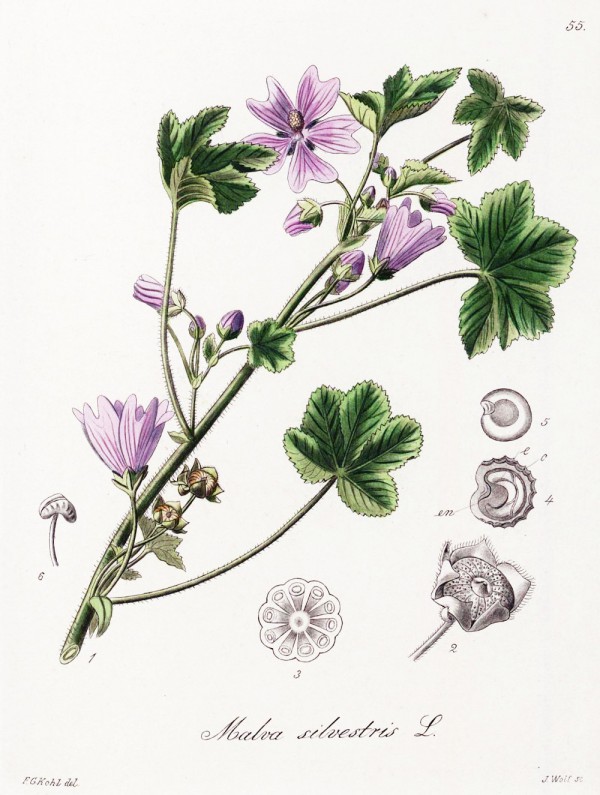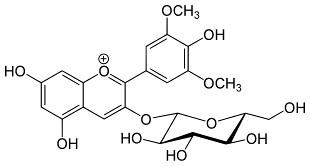Malva sylvestris L. - Malvaceae - common mallow, high mallow, tall mallow, cheeses,
Wilde Malve, Rosspappel, Große Käsepappel
Erect perennial herb, 0.30-1m tall, native to Eurasia; inflorescences erect, axillary, clusters; flowers bright pink, pale in the centre, with darker pink (violet) lines like rays from the centre; petals 15-30mm , sepals 5-7mm long.
M.sylvestris „…is among the oldest known cultivated plants and was already cultivated in ancient times as a vegetable and medicinal plant. Its German trivial name 'Käsepappel' has nothing to do with the poplar, but refers to the cheese loaf-like, mucilaginous fruits, from which was prepared 'Papp' (pap).“
http://de.wikipedia.org/wiki/Wilde_Malve
The main acidic polysaccharide preparation isolated from the leaves of M.sylvestris L. var mauritiana Mill. is composed of l-rhamnose, d-galactose, d-galacturonic acid, and d-glucuronic acid in the molar ratio of 22:6:22:11, and contains 7.7% peptide. The substance showed considerable anticomplementary activity.
[Structure and anticomplementary activity of an acidic polysaccharide from the leaves of Malva sylvestris var. mauritiana., Gonda, R., Tomoda, M., Shimizu, N., Yamada, H., Carbohydrate research, Vol.198(2), 1990, 323-329]
The leaves of M.sylvestris contain 8-hydroxyflavonoid glucuronides like gossypetin 3-glucoside-8-glucuronide and hypolaetin 4′-methyl ether 8-glucuronide, hypolaetin 8-glucuronide and isoscutellarein 8-glucuronide.
[8-Hydroxyflavonoid glucuronides from Malva sylvestris., Billeter, M., Meier, B., Sticher, O., Phytochemistry, Vol.30(3), 1991, 987-990]
The dried leaves (Malvae folium) or flowers (Malvae flos) are used in folk medicine. „The main use of the herb is to treat mucosal irritations of the mouth and throat, that result in dry, irritating cough. It is also considered useful as a mild astringent to treat gastroenteritis. Traditionally it was used internally in case of bladder complaints and externally as a poultice for wounds.“
[Medicinal Plants of the World. Ben-Erik Van Wyk and Michael Wink, Pretoria 2004, 197]
From the aqueous extract of M.sylvestris, eleven compounds were isolated: 4-hydroxybenzoic acid, 4-methoxybenzoic acid, 4-hydroxy-3-methoxybenzoic acid, 4-hydroxycinnamic acid, ferulic acid, methyl 2-hydroxydihydrocinnamate, scopoletin, N-trans-feruloyl tyramine, a sesquiterpene, (3R,7E)-3-hydroxy-5,7-megastigmadien-9-one, and (10E,15Z)-9,12,13-trihydroxyoctadeca-10,15-dienoic acid.
[Antioxidant and radical scavenging properties of Malva sylvestris., DellaGreca, M., Cutillo, F., D'Abrosca, B., Fiorentino, A., Pacifico, S., Zarrelli, A., Natural product communications, Vol.4(7), 2009, 893-896]
M. sylvestris flower extract accelerated wound healing in rats. Extract-treated wounds showed increased well organized bands of collagen, more fibroblasts and few inflammatory cells. The extract effectively stimulated wound contraction as compared to control group and other groups. These findings support the plants traditional use.
[Wound healing activity of Malva sylvestris and Punica granatum in alloxan-induced diabetic rats., Pirbalouti, A.G., Azizi, S., Koohpayeh, A., Hamedi, B., Acta Pol Pharm, Vol.67(5), 2010, 511-516]
http://ptf.content-manager.pl/pub/File/Acta_Poloniae/2010/5/511.pdf
„Malva sylvestris has been used since ancient times for its emollient, laxative and anti-inflammatory properties, being extensively used as salads, soups and teas… The LC–MS analysis of the HE (hydroalcoholic extract) confirmed the presence of scopoletin, quercetin and malvidin 3-glucoside … Topical application of the HE reduced ear oedema, polymorphonuclear cells influx (myeloperoxydase activity and histological analysis) and interleukin-1β levels in the tissue. The topical application of the compound present in the HE, malvidin 3-glucoside was also able to inhibit ear oedema and leukocytes migration. The other tested compounds, scopoletin, quercetin and malvidin 3,5-glucoside were able to prevent the formation of oedema and cell infiltration, but with less effectiveness when compared to HE and malvidin 3-glucoside. Therefore, these results consistently support the notion that M. sylvestris leaves possesses topical anti-inflammatory activity, the compound malvidin 3-glucoside seems to be major responsible for this effect, with the participation of other anti-inflammatory compounds in the extract… M. sylvestris can be used as a future treatment to skin disorders.“
[Pre-clinical anti-inflammatory aspects of a cuisine and medicinal millennial herb: Malva sylvestris L., Prudente, A.S., Loddi, A.M., Duarte, M.R., Santos, A.R., Pochapski, M.T., Pizzolatti, M.G., Otuki, M.F., Food and Chemical Toxicology, Vol.58, 2013, 324-331]
http://www.sciencedirect.com/science/article/pii/S0278691513002858
„The aroma-active compounds of the essential oil from M. sylvestris were identified by GC-O and AEDA… The most strongly aroma-active compound, β-damascenone FD=9, sweet)plays an important role in the characteristic aroma of M.sylvestris. The other strongly affecting aroma compounds, phenylacetaldehyde(FD=8, floral, honey-like)and(E-β-ocimene, FD=8, spicy are concerned with the aroma of the oil. It was revealed that β-damascenone, α-copaene, phenylethyl alcohol, and terpinen-4-ol produce the sweet odor, while phenylacetaldehyde, decanal, α-copaene, and 1-(2-methylene-3-butenyl-1)-(1-methylenepropyl)-cyclopropane create the floral odor of the essential oil in the sniffing test. It seems that all these compounds contribute to the sweet, floral and spicy odor of M. sylvestris.“
[Usami, Atsushi, et al. „Characterization of Aroma-active Compounds in Dry Flower of Malva sylvestris L. by GC-MS-O Analysis and OAV Calculations.“ Journal of oleo science 62.8 (2013): 563-570] https://www.jstage.jst.go.jp/article/jos/62/8/62_563/_pdf

Kohl, F.G., Die officinellen Pflanzen der Pharmacopoea Germanica, t.55 (1891-1895) [F.G.Kohl]
http://plantgenera.org/species.php?id_species=637965
Malva sylvestris
© Rolf Marschner (2018),
www.botanische-spaziergaenge.at
